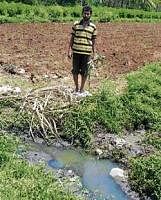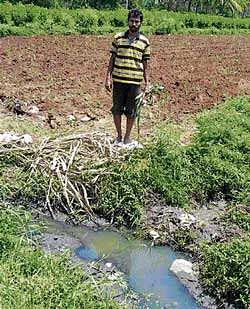

You crinkle your nose and drive past. But those living close to the so-called river, have no option but take in the perfume of inferno with every breathe.
Vrishabhavathi was once a fresh water river. As far as memory serves, it has been nothing but a cesspool, conveying sullage of the City. Industrial, agricultural and domestic wastes have been flowing into the river, making it among the worst contaminated water sources anywhere.
Living at the wrong end of the City, residents of a dozen villages in the river valley are facing two serious problems –– shortage of clean drinking water and horrendous health hazards characterised by ailments, such as asthma, skin and heart diseases. The problem is particularly acute in Byramangala, Chowkalli and Gopalli.
Studies conducted by many research institutions have identified water from the lake as well as open and bore wells in the area as non-potable, with high levels of total and fecal coliforms making them unfit for human use or for any purpose including agriculture.
In their study, ‘Hydrochemical assessment of the pollutants in groundwaters of Vrishabhavathi Valley Basin in Bangalore (India)’, Shankar B S, Balasubramanya N and Reddy M T of the Civil Engineering Department, EPCET, Bangalore have this to say: “The study revealed that 57 per cent of the samples were non-potable due to their values when compared to the BIS standards. The concentrations of nitrate and total hardness were found higher than the standards in 43.33 per cent and 40 per cent of the samples respectively. Nearly 50 per cent of the samples examined indicated bacterial contamination in the groundwater.”
M Jiban Singh and others of Department of Environmental Science, Jnanabharathi, in their study, ‘Bacteriological assessment of groundwater in Arkavathi and Vrishabhavathi basins’, indicate that the coliform count in the water is far, far above the zero levels recommended by the World Health Organisation (WHO).
Farmers say even the crops grown using the water are unfit for human consumption. Boiled, the water leaves heavy sedimentation in the vessels comprising scaling and sludge.
Muddy water
Ramanna, an aged farmer says borewells in all the affected villages yield muddy and smelly water. “Such is our plight that for lack of options, we are forced to drink such sewage.”
Murthy of Chowkalli says the problems is worsening and the the yield of paddy or sugarcane is only half of what used to be earlier.
“We have been forced to get out of agriculture and into dairying. But drinking water is a problem that we have no solutions for.”
Murthy laments that as Bangalore grew his community saw it as an opportunity to have better infrastructure. “Now it has become a curse,” he says.
It is a travesty that the Kirloskar Toyota factory nearby gets fresh Cauvery water from from dozens of kilometres away whereas the nearby villages are dependent on sewage for their drinking purposes, Murthy remarks bitterly. People of Chowkalli have to walk two kilometres from Byramangala cross road to fetch Cauvery water for drinking.
He hopes the government would think of not letting the sullage enter Vrishabhavathi, making a separate path or even insulating the flow of sullage.
A few days ago, Deputy Commissioner Chandrashekharaiah visited the village and the people urged him to provide piped drinking water from Cauvery. The officer promised them that he would look into the issue. The villagers are hanging on to that promise.
That the villages in the vicinity of Bangalore which provide food, vegetables and milk to the City are deprived of a basic necessity like the drinking water is nothing short of a critique of the development priorities of the successive governments.